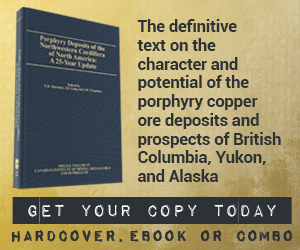Library Magazine Articles Canadian standards for valuation of mineral properties
Canadian standards for valuation of mineral properties
Bill Roscoe and Deborah McCombe - Sep 2008
Mineral property valuations are carried out for a variety of reasons, such as mergers and acquisitions, non-arm’s length transactions, initial public offerings of stocks, support of audited financial statements, fairness opinions, determination of vendor considerations, litigation, expropriation, income tax matters and insurance claims.
The CIMVal Committee was formed in 1999 to review and advise on approaches to the valuation of mineral properties. CIMVal is a special committee of CIM formed on the recommendation of the Mining Standards Task Force of the Toronto Stock Exchange and the Ontario Securities Commission.
After solicitation of views and consultation with various interested parties, the CIMVal Draft Standards and Guidelines for Valuation of Mineral Properties were released for comment in February 2002 and were finalized in February 2003. CIMVal’s objective was for the standards to be used by the mining industry in general and to be adopted by Canadian securities regulators and Canadian stock exchanges. To that end, the standards contain many of the definitions and concepts of National Instrument 43-101, Standards of Disclosure for Mineral Projects, which came into force in February 2001.
The intent of the CIMVal Standards and Guidelines is that mineral property valuations be carried out by appropriately qualified individuals and that all relevant information be fully disclosed. It consists of two parts: standards, which are mandatory in the valuation of mineral properties, and guidelines, which elaborate on the standards and provide guidance and recommendations for the valuation process and for reporting.
Key features of the CIMVal Standards and Guidelines are:
- They cover the valuation of mineral properties but not of corporations.
- They cover metallic and non-metallic mineral properties, both subsurface and surface, and energy fuels. Oil and gas properties are not covered.
- Value refers primarily to fair market value.
- The basic principles are materiality, transparency, independence, competence and reasonableness. Other general valuation principles are outlined in the guidelines.
- A Qualified Valuator (QV) is responsible for the overall valuation and may be assisted by or rely on a Qualified Person (QP) for various aspects. Both the QV and QP must be professionals with at least five years of relevant experience and must belong to a self-regulatory professional organization.
- All technical input to a valuation, including mineral reserves and mineral resources, must be verified by a QP.
- The entity commissioning a valuation must reasonably establish that the QV is sufficiently qualified, competent and independent. Similarly, the QV must be satisfied with the credentials of any QPs involved in the valuation.
- The QV has the responsibility of deciding which valuation approaches and methods to use. The three standard methods of income, market and cost must be considered, and the market and one other approach should be used. Various valuation methods under each approach are discussed in the guidelines, along with comments on their general acceptability/
- The valuation must be reported as a range of values to reflect the uncertainty of the valuation process.
- The valuation must be reported in a valuation report that sets out, among other things, the key risks and assumptions used. The guidelines recommend a table of contents for the valuation report.
- Mineral reserve and mineral resource estimates must be disclosed, and must follow CIM categories and definitions, or other non-Canadian categories as set out in National Instrument 43- 101.
- For income approach methods, such as discounted cash flow, it is generally acceptable to use all Proven and Probable Mineral Reserves, and to use mineral resources that a QP states are likely to be economically viable and for which the higher risk is recognized in the valuation by some appropriate means.
- The valuation date must be specified and all valuations within the previous 24 months must be discussed.
- The valuation report must include certificates of qualifications for the QV and any QPs involved, and a statement that the valuation complies with the standards and guidelines.
The CIMVal standards can be found on the CIM website under Standards and Guidelines.
About the Authors
Bill Roscoe is a consulting geologist and principal with Scott Wilson Roscoe Postle Associates. He is co- chair of the CIM Valuation of Mineral Properties Committee and serves on a task force of the International Valuation Standards Committee.
Deborah McCombe, executive vice president of Scott Wilson Roscoe Postle Associates, is a consulting geologist who is strongly involved in Canadian disclosure standards for the mining industry.

.png)
